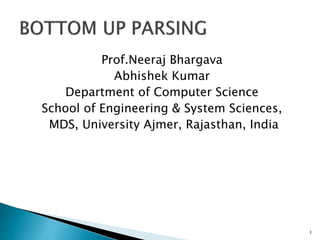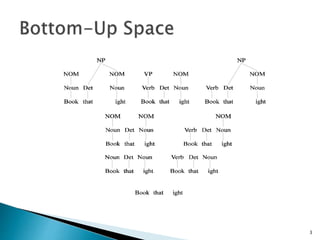Bottom up parsing
- 1. Prof.Neeraj Bhargava Abhishek Kumar Department of Computer Science School of Engineering & System Sciences, MDS, University Ajmer, Rajasthan, India 1
- 2. ï― We also want trees that cover the input words. ï― Start with trees that link up with the words ï― Then work your way up from there to larger and larger trees. 2
- 3. 3
- 4. ï― Top-down âĶ Only searches for trees that can be Sâs âĶ But also suggests trees that are not consistent with any of the words ï― Bottom-up âĶ Only forms trees consistent with the words âĶ But suggests trees that make no sense globally 4
- 5. ï― Which node to try to expand next ï― Which grammar rule to use to expand a node ï― One approach: exhaustive search of the space of possibilities ï― Not feasible âĶ Time is exponential in the number of non- terminals âĶ LOTS of repeated work, as the same constituent is created over and over (shared sub-problems) 5
- 6. ï― DP search methods fill tables with partial results and thereby âĶ Avoid doing avoidable repeated work âĶ Solve exponential problems in polynomial time (well, no not really â weâll return to this point) âĶ Efficiently store ambiguous structures with shared sub-parts. ï― Weâll cover two approaches that roughly correspond to bottom-up and top-down approaches. âĶ CKY âĶ Earley â we will mention this, not cover it in detail 6





